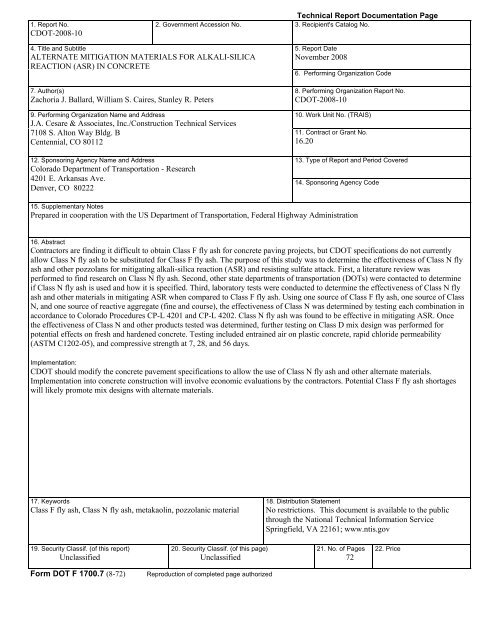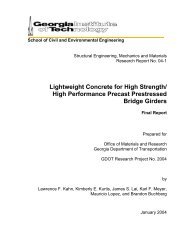Special-Uses-Alkali - Expanded Shale & Clay
Special-Uses-Alkali - Expanded Shale & Clay
Special-Uses-Alkali - Expanded Shale & Clay
Create successful ePaper yourself
Turn your PDF publications into a flip-book with our unique Google optimized e-Paper software.
1. Report No.CDOT-2008-10Technical Report Documentation Page2. Government Accession No. 3. Recipient's Catalog No.4. Title and SubtitleALTERNATE MITIGATION MATERIALS FOR ALKALI-SILICAREACTION (ASR) IN CONCRETE7. Author(s)Zachoria J. Ballard, William S. Caires, Stanley R. Peters9. Performing Organization Name and AddressJ.A. Cesare & Associates, Inc./Construction Technical Services7108 S. Alton Way Bldg. BCentennial, CO 8011212. Sponsoring Agency Name and AddressColorado Department of Transportation - Research4201 E. Arkansas Ave.Denver, CO 802225. Report DateNovember 20086. Performing Organization Code8. Performing Organization Report No.CDOT-2008-1010. Work Unit No. (TRAIS)11. Contract or Grant No.16.2013. Type of Report and Period Covered14. Sponsoring Agency Code15. Supplementary NotesPrepared in cooperation with the US Department of Transportation, Federal Highway Administration16. AbstractContractors are finding it difficult to obtain Class F fly ash for concrete paving projects, but CDOT specifications do not currentlyallow Class N fly ash to be substituted for Class F fly ash. The purpose of this study was to determine the effectiveness of Class N flyash and other pozzolans for mitigating alkali-silica reaction (ASR) and resisting sulfate attack. First, a literature review wasperformed to find research on Class N fly ash. Second, other state departments of transportation (DOTs) were contacted to determineif Class N fly ash is used and how it is specified. Third, laboratory tests were conducted to determine the effectiveness of Class N flyash and other materials in mitigating ASR when compared to Class F fly ash. Using one source of Class F fly ash, one source of ClassN, and one source of reactive aggregate (fine and course), the effectiveness of Class N was determined by testing each combination inaccordance to Colorado Procedures CP-L 4201 and CP-L 4202. Class N fly ash was found to be effective in mitigating ASR. Oncethe effectiveness of Class N and other products tested was determined, further testing on Class D mix design was performed forpotential effects on fresh and hardened concrete. Testing included entrained air on plastic concrete, rapid chloride permeability(ASTM C1202-05), and compressive strength at 7, 28, and 56 days.Implementation:CDOT should modify the concrete pavement specifications to allow the use of Class N fly ash and other alternate materials.Implementation into concrete construction will involve economic evaluations by the contractors. Potential Class F fly ash shortageswill likely promote mix designs with alternate materials.17. KeywordsClass F fly ash, Class N fly ash, metakaolin, pozzolanic material18. Distribution StatementNo restrictions. This document is available to the publicthrough the National Technical Information ServiceSpringfield, VA 22161; www.ntis.gov19. Security Classif. (of this report)Unclassified20. Security Classif. (of this page)Unclassified21. No. of Pages7222. PriceForm DOT F 1700.7 (8-72)Reproduction of completed page authorized















